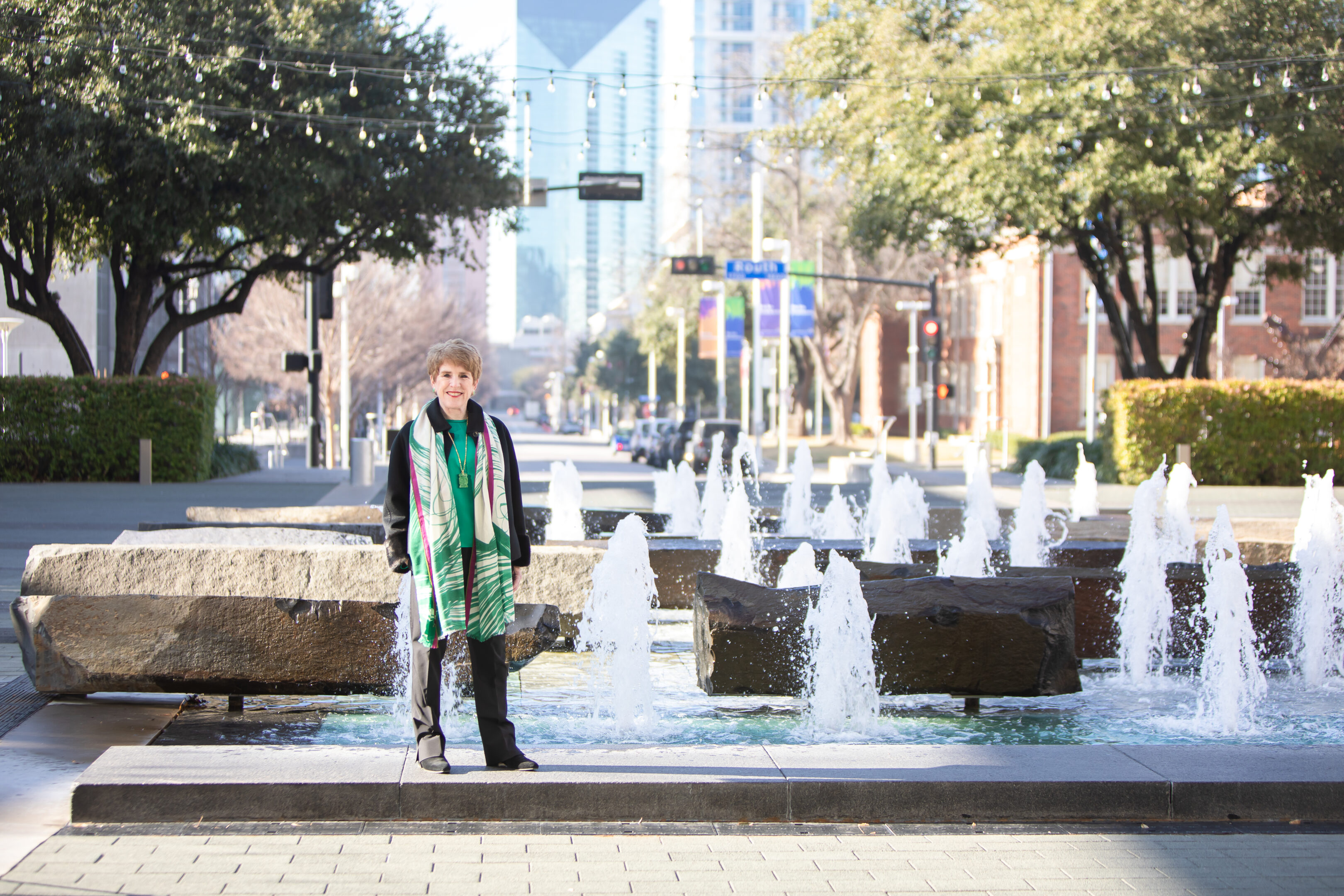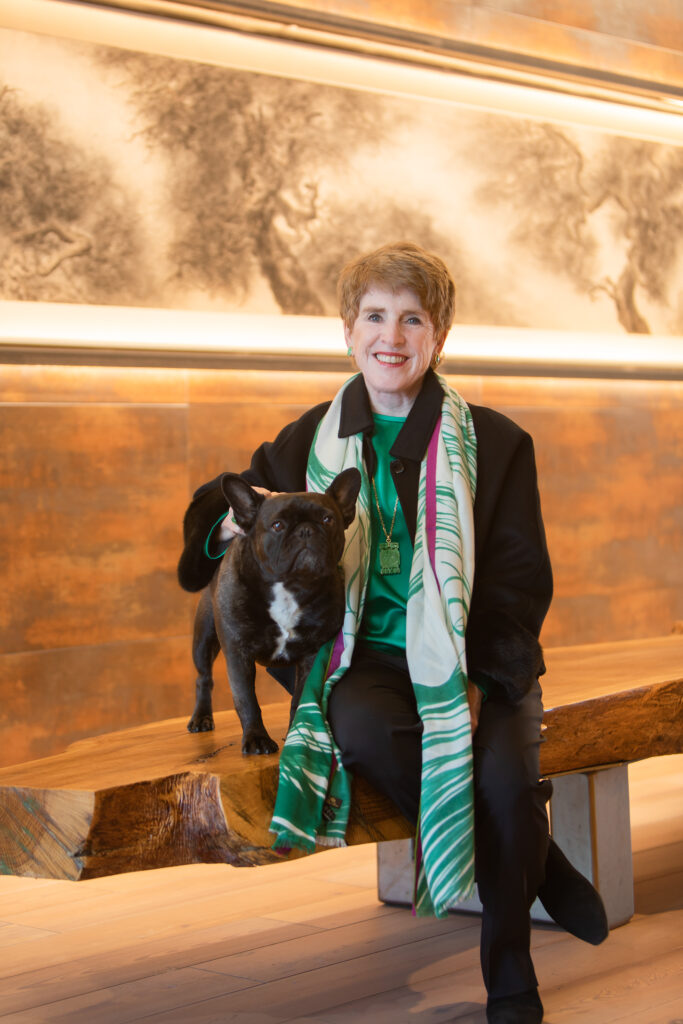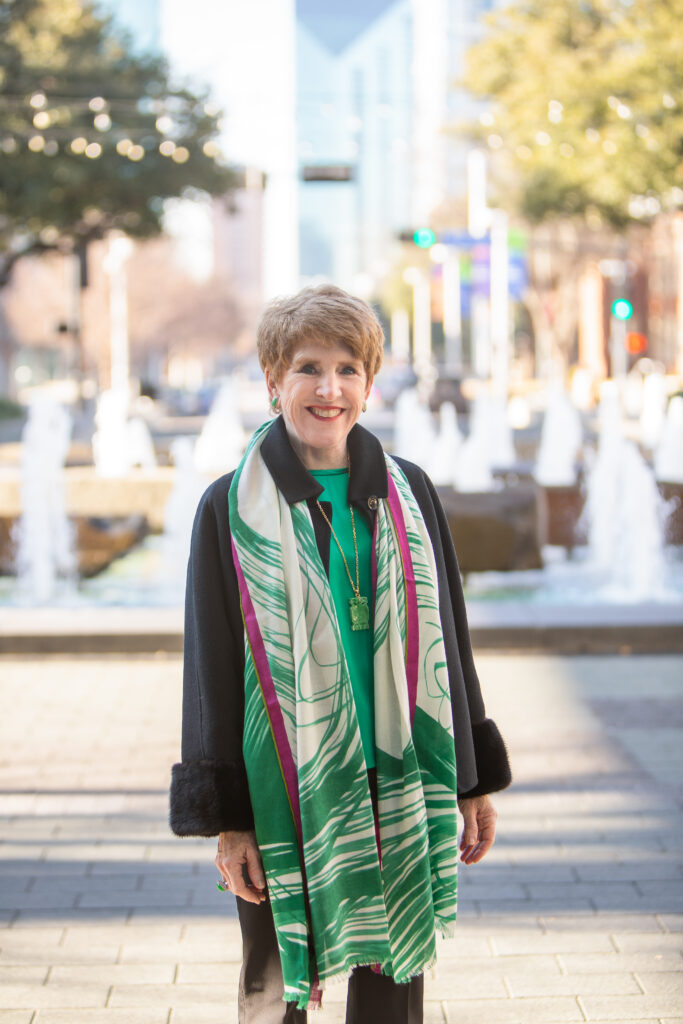Lucy Billingsley
 Photography by Shirley Che
Photography by Shirley Che
MARIA: So you are a developer, you come from a family of developers, led by the legendary Dallas developer Trammell Crow. How has this background informed your views on architecture and place-making?
LUCY: When you grow up and see a father who is crazy about what he does and can’t stop thinking about it, talks about it, taking you to back alleys, parks, kitchens, or whatever experiences are relevant to his current project, you get infected and inspired. As you well know, I have no architectural training and still have poor vocabulary, but I have a great care for how we can create places that will enrich people’s lives. It’s a fabulously creative process that developers get to sneak into the architect’s world and enjoy.
MARIA: I work with different developers around the city, but you just do that so well. You’re so committed and so engaged in doing the right thing, not just for the business, but for the community. That’s one of my favorite things about working with you.
LUCY: I think that’s partly being female.
MARIA: Do you consider yourself a pragmatic or idealist?
LUCY: I am clearly both. Deeply, deeply, both. In the hippie generation, my parents wouldn’t let me be a hippie, but I was at heart. When I went to the University of Texas, first semester I took a course in economics. I said, “Finally there’s a course worth studying! All that liberal arts stuff in high school was driving me crazy!” Now I love them all. I am totally a blend of the two. I aspire for whatever kind of greatness can happen. I’m driven by actually delivering it. And so there comes the practicality.
When you get older, your dreams slip away a little bit because you’re all about delivery, delivery, delivery. And then you look up again and think, ‘Wait, what’s my dream?’ So, I need a little idealism.
MARIA: Your parents collected art, with a big focus on Asian art in particular. How does your interest in art play a role in the work that you do?
LUCY: First, I’m not knowledgeable about art. I’m not trained, and I’m not of the art world. I’m not deeply engaged in what’s the concept the artist had in mind. What I’m engaged in, is how will this art complement the people around it? How will it evoke their sensibilities? Will they feel like they’re in a significant place because of it? Will they feel proud? Will they feel happy? Will they get a laugh? Will they feel quizzical? So art to me is a functional complement to the places we create.
MARIA: That’s an interesting point you’ve made. What it made me think of is the installation in the 9111 at the main [JL1] entrance you have that the piece there. I remember having discussions about it you know, Lucy, your daughter thought the moving was a little less upbeat. I still think it works so well. I guess you know you had that vision, thinking this is going to make people feel special. This is going to make this place feel special. Even though when you look at the art itself, somebody might think it might not make people upbeat, it might make people down. But it really doesn’t have that affect. [JL2]
LUCY: Yeah, that was a risk. She has a bit of a sad expression, but she’s so stunning that you’re not pulled down by it.

MARIA: It’s fascinating to watch people walk by it and realize what they’re looking at. They’ll sort of go back and forth to figure out what’s happening because of the layering. Dallas is often described as a global city. What does that mean to you?
LUCY: If you look at the great cities on Earth, if you look at the cities that are building, and creating amazing places of tomorrow, we are certainly in the top 10. We have tremendous growth, tremendous institutions, where we’ve become national leaders in the arts now. We got an opportunity, and we got an obligation.
The opportunity, when we get to build so much, obviously is to create these amazing places that will enrich with time. The obligation is to do exactly that. And to do it for the population of tomorrow because we’re global, we’re international. We need to reflect the sensibilities of all the cultures that are with us. So it’s in art and architecture. It’s in the World Affairs Council, it’s in the symphony. You know it’s inherent in all of us to rise to the occasion.
LUCY: We’re lucky to have some large developments; we have a big canvas to work on. Just to jump to favorite cities, Paris is easy to put at the top. It is the public space, and how the buildings complement that, and the height of the building is hugely important for the human scale. Then you jump over to Singapore, and all of their buildings either have balconies, openings or trees growing on them. That changes the building from being an edifice to being connected to the space below and around it. And it takes the ground plane up higher. The gift from those ideas from these cities and their integrity in their architectural controls is fantastic.
MARIA: Have you started to implement some of those? Like Singapore, for example, where you see a lot of green spaces percolating up into the building.
LUCY: What we’ve started at Cypress Waters is saying that all the buildings that are near the water have to have the balconies. We have the stage called The Sound and a park. That lets the office worker walk out and get fresh air without a big ordeal. We all need trees to change our blood pressure and our heartbeat. It rejuvenates us in significant ways. Better to be on the ground looking up and better to be inside living with it.
MARIA: Isn’t it true that even today it’s more relevant than ever that we’re understanding how important outdoor spaces are for our health, especially with COVID-19 and the need to socially distance.
LUCY: So, we got the lesson from COVID and the commitment, but this is something that should be with us forever.
MARIA: The new Crow Museum is moving to the University of Texas at Dallas campus. What does that mean for arts and culture in the city and North Texas in your perspective?
LUCY: First, we’re greatly complimented that UTD was so eager and interested to actually expand the museum there, so it will continue to have the downtown presence. But what that does is many things. One, it brings that collection of art to that student body and to those professors so it can be used in an academic environment. Two, it brings it to the local community. The campus probably is an easy 15-20 miles from downtown, so it opens that whole collection up to a large part North Dallas. The outreach for us is just wonderful on many fronts.
MARIA: How do you see COVID changing your strategies for workplace and multifamily development?
LUCY: COVID’s got a tremendous impact on how we develop and how we manage our properties. On the development side in the commercial arena, there’s thoughtfulness to the outdoor spaces access. Easy access is one. And the whole non-touch environment has many aspects to it. Obviously, how people lay out their spaces and think through the cleanliness of kitchens and other spaces. In the multi-family arena, it has equally or maybe more significant impact as people work from their homes. You think about the interior of the unit. You think about the amenities and the access to other areas to have, to be able to go to, so people don’t have to be in a small space day after day. You think about the live-work units that have been developed and will be developed, how do we make those be more actively used with access to public spaces. We think about the events and the entertainment with people being there so much more. How do we create community and people have connectivity to their neighbors in safe ways? We think the office market will stay strong, but obviously the spaces and the integrity of dealing with future pandemics will be embedded into our properties from here on out.

MARIA: Is there something your group is doing specifically to retrofit existing developments?
LUCY: In our office buildings, we have all handles with copper wrapped around them. We’ve come in with distancing programs that are very visible, so people know what to do in elevators. And we’ve come in with cleaning programs that are much more in depth, and we have follow-up cleaning programs if anyone has had COVID and been in a certain place. We’re looking more into the air conditioning systems that can mirror what hospitals are doing, so we’re learning from the medical community, saying, “How do we bring their standards into commercial places?” And then we’re focused on no-touch entrances.
MARIA: So, Lucy, talk about your legacy and where you would like the next generation to take what you and Henry have built through the years?
LUCY: I don’t really focus much on legacy, I focus on the next deal. Our kids own our business, and each one runs a different portfolio. My interest is launching them, which we have, into building careers of their own. I guess the legacy would be for them to carry our values forth and our care. And I think we are safe at home.
MARIA: Indeed! Having worked with you and your daughter Lucy has been a great experience to see how different you are in many ways, but at the same time how those values are embedded in her thought process. It’s been a lot of fun.
Interview conducted by Maria Gomez, AIA, a principal at GFF.